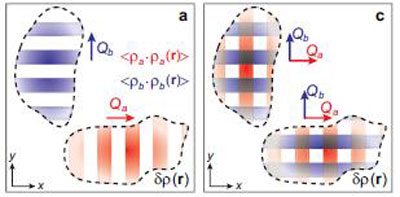| Posted: Mar 20, 2015 |
You can't play checkers with charge ordering
|
|
(Nanowerk News) Canadian Institute for Advanced Research (CIFAR) fellows were among physicists who observed the shape of a strange phenomenon that interferes with high-temperature superconductivity called charge ordering, discovering that it is stripy, not checkered, and settling a long-standing debate in the field.
|
|
Charge ordering creates instability in some metals at temperatures warmer than about -100 degrees Celsius, causing some electrons to reorganize into new periodical static patterns competing with superconductivity. But scientists wonder if it may also play an essential role in propelling electrons into the tight pairs that allow them to travel without resistance.
|
|
In order to understand what charge ordering does, and whether it's a hindrance, a help, or a bit of both, scientists must first understand what it is -- starting with its shape.
|
 |
| These graphics show the static patterns for 1-D stripy charge order (a) and for 2-D checkerboard charge order (b), within the 2-D Cu-O plane. (Image: R. Comin et al)
|
|
Riccardo Comin, lead author on a new paper in Science ("Broken translational and rotational symmetry via charge stripe order in underdoped YBa2Cu3O6+y"), set out to determine whether the pattern of charge ordering was a checkerboard or a series of stripes by x-raying very cold yttrium barium copper oxide. His collaborators at the Quantum Matter Institute of the University of British Columbia included CIFAR Global Scholar Eduardo da Silva Neto and senior fellows of the Quantum Materials program Ruixing Liang, Walter Hardy, Doug Bonn, George Sawatzky, and Andrea Damascelli - who is Comin's PhD supervisor and team leader of this study.
|
|
They found the pattern is striped, meaning the electrons self-organize along one direction (1D), rather than in two directions (2D) as they would in a checkerboard pattern. However, when the temperature cools down far enough, charge ordering dies off and superconductivity takes over, allowing electrons to travel freely with no resistance, no longer constrained to one dimension.
|
|
The result is exciting because physics is much more interesting in low dimension, says Damascelli. And in the cuprates these 1D patterns are realized within the 2D Cu-O planes, which already con-strain the motion of electron to less than 3D, even before charge ordering sets in.
|
|
"Superconductivity in conventional 3D metals is limited to a Tc of few degrees Kelvin," he says, citing examples such as aluminum and niobium. "High temperature superconductors are quasi 2D metals, and now with a tendency toward 1D electronic ordering."
|
|
Furthermore, the researchers found that charge ordering competes with superconductivity much more strongly along one direction than the other. The results are an important step in knowing what drives superconductivity and what my hinder it.
|
|
"Is charge ordering just an anomaly, or is it there in all these systems because there is an underlying interaction which isn't completely removed from superconductivity?" Comin asks. "The two phenomena are competing but in a sense they're also interconnected."
|
|
Damascelli says the material in this study, yttrium barium copper oxide, is the superstar of copper-oxides because of its exquisite purity and high transition temperature. It's also a Canadian success story -- CIFAR fellows Liang-Bonn-Hardy are leading growers and suppliers of the crystal for re-search the world over. "That's why the Canadian groups and in particular the CIFAR program has had such an impact, because we had access to the best materials," Damascelli says.
|

